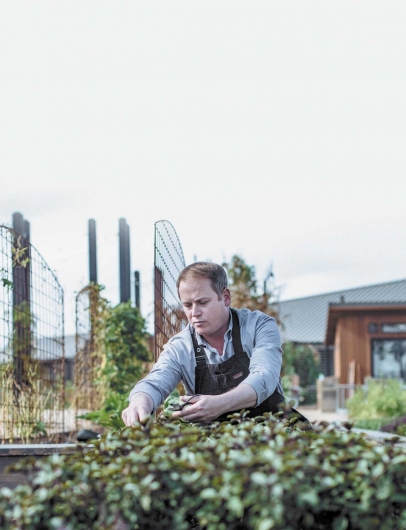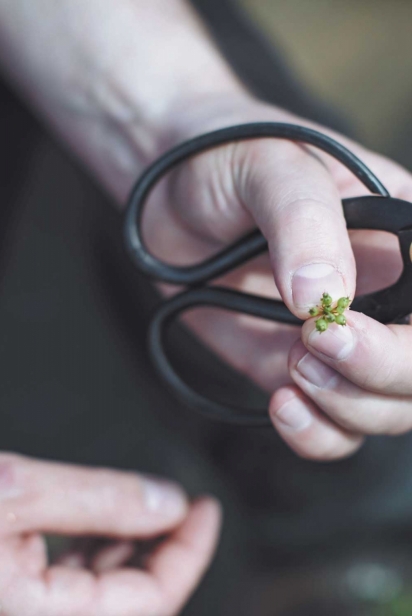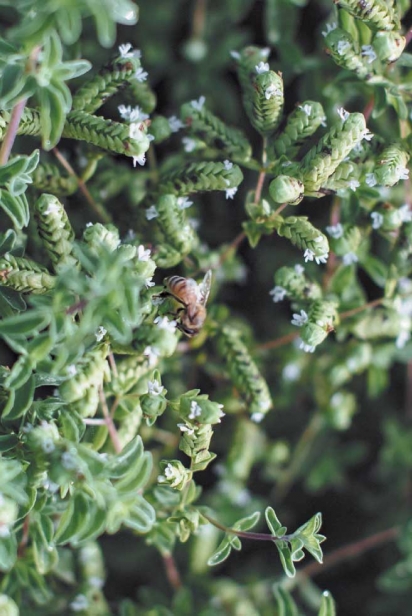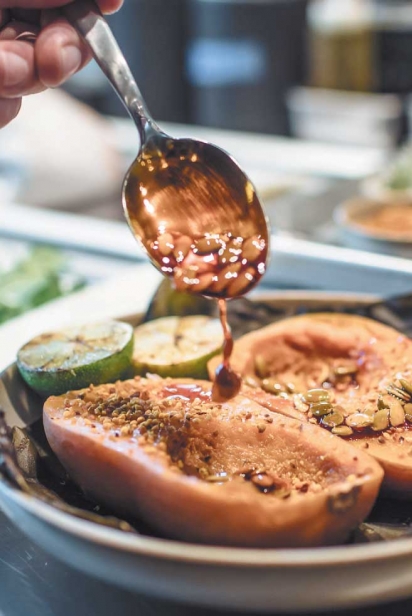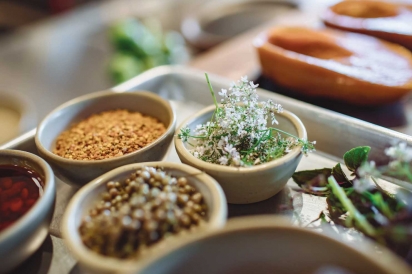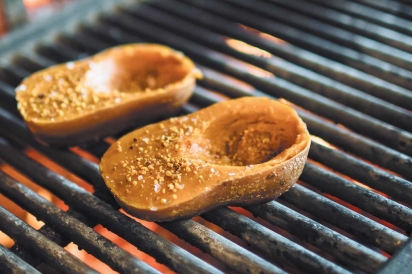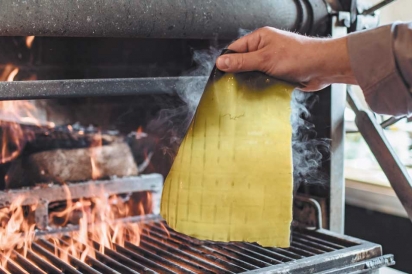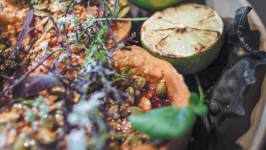Escoffier Questionnaire: Chef Garrison Price
“I think people are still figuring out that we are open.” Executive Chef Garrison Price and his team of 76 cooks opened Bear and three other dining experiences at Stanly Ranch earlier this year. The 700-acre destination is the third Auberge property in the Napa Valley.
Beyond the hub of food, wine and spa, the land includes a culinary garden, luxe cottages, vines on rolling hills and plenty of open space. It is a Wine Country dream. Perhaps for Chef Price, as much as anyone else.
“[My now fiancée] and I went on a trip to Santa Barbara, to our friend Chad Melville’s winery, and we were joking about moving to California [from New York]—and the next week I got the call about this.”
We start our conversation, fittingly, where many meals begin— in the garden. Stanly Ranch’s Farm Director Nick Runkle shares that the long table that sits amidst the ’tween-seasons-but-still-fecund raised-bed garden boxes has become the “venue of choice” for events at Stanly Ranch. “We talk a lot about soil nutrition and that’s one of the things I’m most interested in. Because I already know my vegetables pretty well,” adds Chef Price. “It kind of blew my mind that the DNA of the seeds from last season’s plants is already more well adapted to this place. Selfishly, the work that Nick is doing is part of why I’m so excited to be here.”
Through many Covid-caused delays to opening, the kitchen had a lot of garden produce to play with. They experimented with another process that animates Chef Price: fermentation. “We’ve got some weird garums going. We love fish sauce. We’re making miso with split peas and sourdough bread.” With dried and brined blossoms, pickled coriander berries and fermented chiles, the kitchen’s designated fermentation facility is in constant conversation with the seasons.
Running an operation of this size oftentimes means being more leader than cook. “I think Chef Jean-Georges Vongerichten was probably the biggest influence on me, as far as leadership,” says Price. “It’s all about communication. Give everyone the information before something happens. I get to be a creative driving force behind it because of the team that I have.”
He continues, “I always loved to cook, but growing up in Rockford, Illinois, I didn’t try sushi until I was 18.” Late to work at his job as a busboy one day, the owner “punished him” by putting him in the kitchen to prep. When they asked him to make a mirepoix, he jumped right in. “I could hear them whispering, like ‘Whoa, this kid knows his stuff.’” Maybe it was the years of watching PBS cooking shows after school.
“After high school, I wanted to get as far away from Rockford as possible, but where they still spoke English. So I went to Australia for a bit. When I came back to Rockford, I needed a job. A friend of mine worked at a French and Italian restaurant. I cut myself, like, five times in the first day. But I got good at not making the same mistake twice. Chef Philippe there was from Montpellier, France, and he had worked on the Orient Express and all these other amazing places. He married a woman from Rockford and that’s where they decided to set up shop, so the level of cuisine that I was learning was actually very world-class.”
“Then my older brother sent my resume around Chicago, to get me out of Rockford. In 2001, I was working through Charlie Trotter’s and Tru, arguably the best restaurants in the world at that time. It was really intense. Then Peninsula Chicago was opening and I went with Chef Graham Elliot Bowles to open that rare occurrence of a really high-caliber restaurant in a hotel.
“That’s where my mind was just blown, coming from this classical French background to learning about regional Chinese dim sum. And then being able to eventually go on task force to Hong Kong and spend some time cooking there. To be fully immersed in these different styles of cooking and kitchen culture. And also finding the similarities.”
From there, Chef Price moved to Portland, Oregon, for his first experience opening a new place himself. At The Nines, a luxury hotel, he “fell in love with working with farms and the wine community. I am always up for an adventure,” he says.
“After [doing] a lot of events at the hotel, I knew that I needed to get back into the restaurant. So I got really lucky with a chef de cuisine position in Kauai. And then I got to do a tasting for Jean-Georges [Vongerichten] in New York City. I did it just to do it. At Bear, I prepared a 10-course tasting menu [before being hired]. For Jean-Georges, it was only three dishes: one of your own dishes; one of his recipes (the most elaborate, which is, like, a three-page halibut recipe. Everything’s to the gram.); and then a ‘black box.’ You have, like, a three- by two-foot corner of a table to work in a busy kitchen and it’s just you and a lot of opinions around. I brought some tuna that my friend had caught in a cooler all the way from Kauai for my dish. I think the tuna Jean-Georges [already] had in the kitchen was better than mine, but the story sold it.”
“Apparently I did something right, and they invited me to move to New York City. I was a culinary trainer. We opened about nine restaurants in three years. I got to go to Abu Dhabi, Doha, London, all over. It was so inspiring cooking with young people that are excited to learn.” But traveling 200 days a year is not easy and not conducive to relationships.
So he moved on to a stint with José Andres at China Poblano in Vegas. “It’s one of my favorite restaurants of all time. It’s not fusion, but really traditional dim sum and then Mexican cooking, which I knew nothing about. I got to spend some time in the Yucatan learning.”
“I was hankering to get back into fine dining and I sat down with Donna Leonard from NoHo’s [the New York City neighborhood] Il Buco, now an institution, and once the New York vanguard of regional Italian cooking. And I think I was also interviewing for global culinary director for Whole Foods at the same time. It was a crossroads. I went to Il Buco. Working for her [Leonard] was the best thing I could have done.
“At Il Buco, I got to cook for Alice Waters. We got into the idea of having the ‘best’ salt or the ‘best’ olive oil. We went to Sicily and the food literally made me cry. And no one made fun of me. The adjacency of Italian cooking and California cuisine taught me about following the seasons and paying tribute to the raw ingredient.”
After opening the “only in New York” Il Fiorista, a floral design shop/botanics-inspired restaurant, Covid-19 hit and the New York restaurant scene was placed on hold. Chef Price says the move west was a welcome new start.
“You could say I was part of the ‘great resignation.’ Even more so for the cooks. It’s been so painful being out of the game and then getting back into the game. It’s not easy. What we’re building here at Stanly Ranch is pretty flexible, because we have enough people between the [several] restaurants. We’re very lucky to have that. Ultimately, this is about being able to serve a community.”
That community extends to Bear’s relationship with their farmer partners. “We try to think a season ahead. If we make a commitment to buy something, we know that can have a huge impact on a farm.”
The food at Bear is a collaboration between Price, Executive Sous Chef Anthony Stagnaro, Pastry Chef Harry Flager, Farmer Nick Runkle and many others. The open kitchen and open energy among the team lend grace to the property. The food is also very much a particular expression of Chef Price and his story. Global influences, long fermentation, seasonal cooking and high-level technique come together in dishes like crispy rice with Thai bird chilies, shiitake pickles and coconut. Everything is fresh and complex, a particularly delicious tightrope walk when accomplished.
“I know luxury for some is about a stunning room and fine linens, but for me it’s all about our laminated pastries. We have someone just laminating dough all day. That is true luxury.”
Chef Garrison Price, Bear at Stanly Ranch, Napa
Edible Marin & Wine Country:
What was the first meal you made that you were proud of?
Chef Price:
The whole Thanksgiving spread when I was 12 years old
What was your favorite food as a kid?
A PB&J sandwich
What food do you wish you loved?
I wish I loved cannoli—they bring people so much joy.
What food do you love unreasonably much?
Lemon. I can put lemon on literally everything.
What is the most difficult cooking technique to do well?
Baking
What are you exploring in your kitchen now?
Making miso, particularly miso made with ingredients other than soybeans
What nonculinary influence inspires you?
Music and musicians. Jimi Hendrix, in particular.
What is your idea of a very healthy meal?
Bitter greens, quinoa, avocado and pomegranate
What is your favorite ingredient?
Colatura, fancy anchovy fish sauce
What is your favorite hangover meal?
Beef pho with extra beef tendon
What restaurant in the world are you most dying to try?
DiverXO in Madrid, Spain
What kitchen utensil is most indispensable to you?
A spoon
Whom do you most like to cook for?
My finance, Adrianna
If you could do one other job, what would it be?
A cultural anthropologist
What is your favorite midnight snack?
Popcorn with sea salt, parmesan cheese and hemp seeds
What most satisfies your sweet tooth?
Chocolate in any form
What would you eat at your last meal, if you could plan such a thing?
Adrianna’s roast chicken.
What’s your favorite place to go for (and what is your favorite thing to order) for …
… a splurge meal? The whole menu at Napa’s Torc from Chef Sean O’Toole
… breakfast? I don’t eat breakfast, but it would be brunch at Valley Bar & Bottle in Sonoma for the Valley breakfast and the hippie salad
… pastry? Passionfruit macarons from Yountville’s Bouchon
… a late-night/after-work meal? Grilled cheese at Cadet Wine & Beer Bar in Napa
… a cup of coffee? A Sightglass Coffee cortado at Gavel coffee shop here at Stanly Ranch
… a greasy-spoon meal? It’s not exactly a greasy spoon, but the Loveski reuben sandwich at Chef Chris Kostow’s Loveski Deli at Oxbow Public Market in Napa
… groceries? I love the hyper-seasonal produce from Hudson Greens & Goods at Oxbow Public Market in Napa.
… kitchen equipment? Hestan Titum nonstick pans for cooking eggs
… ice cream? The Gansito ice cream at La Michoacana in Sonoma
… chocolate? Earl Grey Bon Bons from Chris Kollar’s chocolate shop in Yountville
And lastly but not leastly …what is your favorite local wine or beer for the season?
Sandlands 2020 Contra Costa County Carignane wine made by Tegan Passalacqua
Marissa La Brecque is the principal at Hyperflore Brand Strategy + Storytelling.


